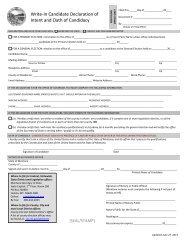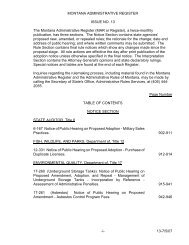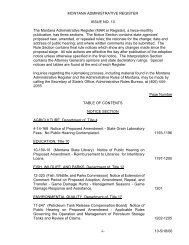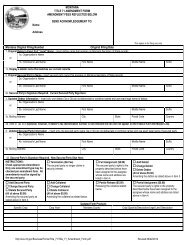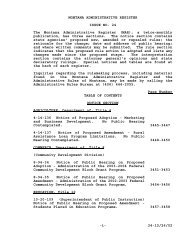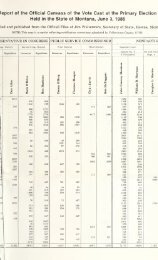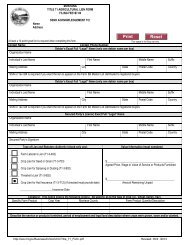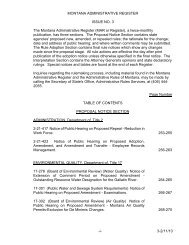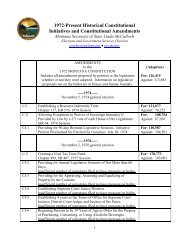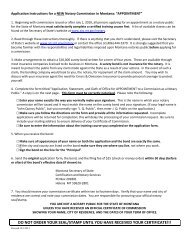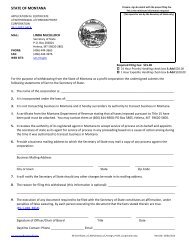Notary Handbook - the Montana Secretary of State Website
Notary Handbook - the Montana Secretary of State Website
Notary Handbook - the Montana Secretary of State Website
Create successful ePaper yourself
Turn your PDF publications into a flip-book with our unique Google optimized e-Paper software.
SAMPLE JOURNAL ENTRIES<br />
The <strong>Secretary</strong> <strong>of</strong> <strong>State</strong> has not defined a specific format for <strong>the</strong> <strong>Notary</strong> Journal. You may choose <strong>the</strong> design that fits<br />
your particular demands best. There are several designs on <strong>the</strong> market; all <strong>of</strong> <strong>the</strong>m include spaces for <strong>the</strong><br />
information required by <strong>Montana</strong> law. You do not need to fill out sections requesting information not required by<br />
law, such as thumbprints. The required information is <strong>the</strong> same for both paper and electronic journals – only <strong>the</strong><br />
method <strong>of</strong> recording is different.<br />
Below is a list <strong>of</strong> <strong>the</strong> information that must be included in every journal entry, regardless <strong>of</strong> <strong>the</strong> format:<br />
<br />
<br />
<br />
<br />
<br />
<br />
<br />
Date Notarized: This is <strong>the</strong> date on which you actually performed <strong>the</strong> notarization; it may or may<br />
not be <strong>the</strong> same as <strong>the</strong> date <strong>of</strong> document, which may be earlier but not later than <strong>the</strong> date <strong>of</strong><br />
notarization.<br />
Type <strong>of</strong> Notarization: There are seven types <strong>of</strong> notarial acts: an ACKNOWLEDGEMENT, a<br />
SIGNATURE, a JURAT, an OATH, a CERTIFIED COPY, a DEPOSITION, and a PROTEST OF INSTRUMENT.<br />
See pages 13 - 14 for more information about <strong>the</strong> types <strong>of</strong> notarial acts and how you determine<br />
which act a particular document demands.<br />
Date <strong>of</strong> Document: This date can be <strong>the</strong> date<br />
<strong>the</strong> document was issued or <strong>the</strong> date it was<br />
signed and is usually printed on <strong>the</strong> document<br />
before it is signed. If no date appears on <strong>the</strong><br />
document, you may consider <strong>the</strong> date <strong>of</strong><br />
notarization as <strong>the</strong> date <strong>of</strong> <strong>the</strong> document.<br />
Type <strong>of</strong> Document: This can be a very generic<br />
term <strong>of</strong> art (i.e., “contract”, “motion”), a form<br />
number, or a short description <strong>of</strong> <strong>the</strong><br />
document. The signer must be able to explain<br />
to you what type <strong>of</strong> document is being signed<br />
if it is not obvious to you.<br />
Type <strong>of</strong> ID: Again, your possible entries are<br />
limited: If you know <strong>the</strong> signer well, enter<br />
PERSONAL KNOWLEDGE; if you are relying on<br />
SATISFACTORY EVIDENCE, you should just<br />
enter <strong>the</strong> issuing entity and type <strong>of</strong> document<br />
(ex: “<strong>Montana</strong> DL”); and finally, if you rely on<br />
a CREDIBLE WITNESS your journal should<br />
reflect that you performed two separate<br />
When performing a<br />
notarization, we recommend that<br />
you complete <strong>the</strong> journal entry<br />
first and have <strong>the</strong> signer<br />
enter his/her printed name,<br />
address, and signature before<br />
you complete <strong>the</strong> notarial block<br />
on <strong>the</strong> document.<br />
notarial acts, including <strong>the</strong> oath <strong>of</strong> <strong>the</strong> credible witness and <strong>the</strong> acknowledgement, signature, or<br />
jurat <strong>of</strong> <strong>the</strong> signer.<br />
The Printed Name, Signature, And Address <strong>of</strong> <strong>the</strong> Signer: This is absolutely <strong>the</strong> most important<br />
entry in <strong>the</strong> journal. This proves that <strong>the</strong> signer was in your physical presence at <strong>the</strong> time <strong>the</strong><br />
notarization was performed. Whenever possible, <strong>the</strong> printed name and address should be entered<br />
by <strong>the</strong> customer; <strong>the</strong> signature, <strong>of</strong> course, must always be entered by <strong>the</strong> customer.<br />
O<strong>the</strong>r Information: Use this space to include any information that may be pertinent to <strong>the</strong><br />
situation. It is especially helpful to note anything unusual or additional that occurred or was a part<br />
<strong>of</strong> <strong>the</strong> transaction. Many journal entries will not require any additional information.<br />
11



